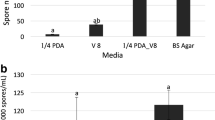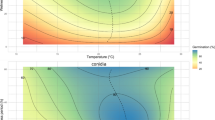Abstract
The effect of conidial concentration and length of stigma wetness period on infection of sorghum spikelets by Claviceps africana was studied in a controlled environment experiment. Aspore concentration of at least 106 conidia/mL was required for maximum infection on sorghum panicles. Maximum infection occurred during a stigma wetness period between 4.5 and 6 h. Approximately 11–15% infection occurred when stigmas had been dried immediately after inoculation. This study demonstrated that the stigma wetness is an important parameter in sorghum ergot epidemiology.
Similar content being viewed by others
References
Anahosur KH, Patil HS (1982) Effect of date of sowing on the incidence of ergot of sorghum. Indian Phytopathology 35, 507–509.
Bandyopadhyay R, Frederickson DE, McLaren NW, Odvody GN, Ryley MJ (1998) Ergot: a new disease threat to sorghum in the Americas and Australia. Plant Disease 82, 356–367. doi: 10.1094/PDIS.1998.82.4.356
Bhuiyan SA (2002) The biology and control of ergot (Claviceps africana) in Sorghum. PhD Thesis, The University of Queensland, Gatton.
Bhuiyan SA, Galea VJ, Ryley MJ, Tay D, Lisle AT (2002) Factors influencing the germination of macroconidia and secondary conidia of Claviceps africana. Australian Journal of Agricultural Research 53, 1087–1094. doi: 10.1071/AR02029
Blaney BJ, McKenzie RA, Walters JR, Taylor LF, Bewg WS, Ryley MJ, Maryam R (2000) Sorghum ergot (Claviceps africana) associated with agalactia and feed refusal in pigs and dairy cattle. Australian Veterinary Journal 78, 102–107. doi: 10.1111/j.1751-0813.2000.tb10535.x
Bogo A, Mantle PG (1999) Claviceps africana discovered in India. Plant Disease 83, 79. doi: 10.1094/PDIS.1999.83.1.79B
Frederickson DE, Mantle PG, de Millano WAJ (1989) Secondary conidiation of Sphacelia sorghi on sorghum, a novel factor in the epidemiology of ergot disease. Mycological Research 93, 497–502. doi: 10.1016/S0953-7562(89)80042-5
Frederickson DE, Mantle PG, de Millano WAJ (1993) Windborne spread of ergot disease (Claviceps africana) in sorghum Alines in Zimbabwe. Plant Pathology 42, 368–377. doi: 10.1111/j.1365-3059.1993.tb01514.x
Futrell MC, Webster OJ (1965) Ergot infection and sterility in grain sorghum. Plant Disease Reporter 49, 680–683.
Futrell MC, Webster OJ (1966) Host range and epidemiology of sorghum ergot organism. Plant Disease Reporter 50, 828–831.
Isakeit T, Odvody GN, Shelby RA (1998) First report of sorghum ergot caused by Claviceps africana in the United States. Plant Disease 82, 592. doi: 10.1094/PDIS.1998.82.5.592A
Kulkarni GS (1942) Ergot in India. Current Science 11, 246.
McLaren NW, Flett BC (1998) Use of weather variables to quantify sorghum ergot potential in South Africa. Plant Disease 82, 26–29. doi: 10.1094/ PDIS.1998.82.1.26
McLaren NW, Wehner FC (1990) Relationship between climatic variables during early flowering of sorghum and the incidence of sugary disease caused by Sphacelia sorghi. Journal of Phytopathology 130, 82–88. doi: 10.1111/j.1439-0434.1990.tb01155.x
McLaren NW, Wehner FC (1992) Pre-flowering low temperature predisposition of sorghum to sugary disease (Claviceps africana). Journal of Phytopathology 135, 328–334. doi: 10.1111/j.1439-0434.1992.tb04318.x
Molefe TL (1975) Occurrence of ergot on sorghum in Botswana. Plant Disease Reporter 59, 751–753.
Musabyimana T, Sehene C, Bandyopadhyay R (1995) Ergot resistance in sorghum in relation to flowering, inoculation technique and disease development. Plant Pathology 44, 109–115. doi: 10.1111/j.1365-3059.1995.tb02722.x
Quinby JR (1958) Grain sorghum production in Texas. Texas Agriculture Experiment Station Bulletin 912. Texas A&M University, College Station.
Reed JD, Ramundo BA, Claflin LE, Tuinstra MR (2002) Analysis of resistance to ergot in sorghum and potential alternate hosts. Crop Science 42, 1135–1138.
Reis EM, Mantle PG, Hassan HAG (1996) First report in the Americas of sorghum ergot disease, caused by a pathogen diagnosed as Claviceps africana. Plant Disease 80, 463.
Ryley M (2005) Pollen release in the Australian grain sorghum hybrid, MR Buster. International Sorghum and Millets Newsletter 45, 25–28.
Ryley MJ, Alcorn JL, Kochman JK, Kong GA, Thompson SM (1996) Ergot on Sorghum spp. in Australia. Australasian Plant Pathology 25, 214. doi: 10.1071/AP96038
Ryley MJ, Herde DJ, Bhuiyan SA, Henzell RG, Jordan DR (2002) An overview of the biology of sorghum ergot. In ‘Sorghum and millets diseases’. (Ed. JF Leslie) pp. 141–150. (Iowa State University Press: Ames, IA)
Sangitrao CS, Bade GH (1979) Meteorological factors associated with honeydew development and sclerotial stage in sorghum ergot. Sorghum Newsletter 22, 107–108.
Tegegne G, Bandyopadhyay R, Mulati T, Kebede Y (1994) Screening for ergot resistance in sorghum. Plant Disease 78, 873–876.
Thakur RP, Rao VP, King SB (1991) Influence of temperature and wetness duration on infection of pearl millet by Claviceps fusiformis. Phytopathology 81, 835–838. doi: 10.1094/Phyto-81-835
Tonapi V, Ryley M, Galea G, Bhuiyan S, Wearing A (2002) Influence of temperature and relative humidity on pollen traits and ergot severity in sorghum. International Sorghum and Millets Newsletter 43, 74–76.
Tonapi VA, Ryley MJ, Galea V, Bhuiyan S, Wearing A (2003) Simple techniques for production of secondary conidia and ergot inoculation in sorghum. International Sorghum and Millets Newsletter 44, 97–99.
Workneh F, Rush CM (2006) Weather factors associated with development of sorghum ergot in the Texas panhandle. Plant Disease 90, 717–722. doi: 10.1094/PD-90-0717
Workneh F, Narasimhan B, Srinivisan R, Rush CM (2006) Assessment of regional site-specific sorghum ergot severity potential using radar-rainfall measurement. Plant Disease 90, 704–707. doi: 10.1094/PD-90-0704
Author information
Authors and Affiliations
Corresponding author
Rights and permissions
About this article
Cite this article
Bhuiyan, S.A., Ryley, M.J., Galea, V.J. et al. Effects of conidial concentration and stigma wetness period on infection by the sorghum ergot pathogen Claviceps africana . Australasian Plant Pathology 38, 496–499 (2009). https://doi.org/10.1071/AP09032
Received:
Accepted:
Issue Date:
DOI: https://doi.org/10.1071/AP09032




